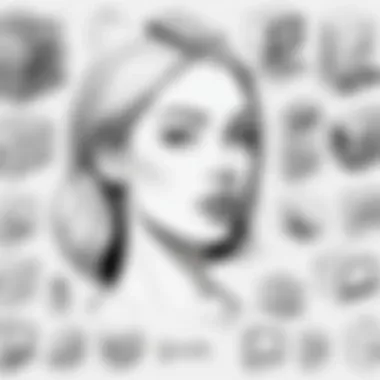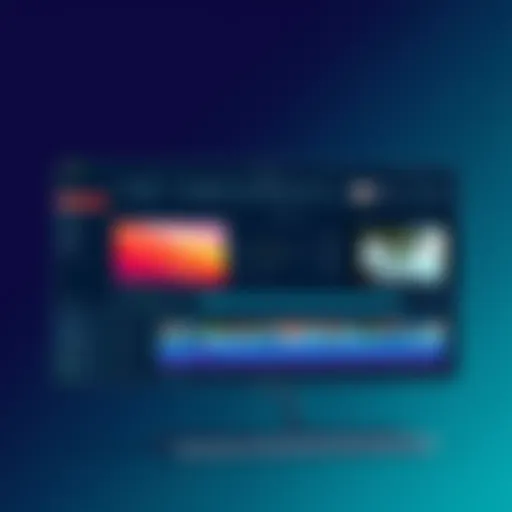Evaluating Drawing Platforms for Mac: A Comprehensive Guide


Intro
The landscape of drawing platforms for Mac is rich and diverse. Many artists and professionals often find themselves navigating numerous options, each with its own unique features and capabilities. Understanding these tools is essential for maximizing creativity and productivity. Choosing the right drawing software can significantly impact workload efficiency and final output quality.
This guide aims to provide an exhaustive analysis of various drawing platforms available for Mac. It focuses on essential aspects, such as features, functionalities, and user experiences. Furthermore, it assists users in making informed choices that align with their artistic and professional needs.
Software Category Overview
Purpose and Importance
Drawing platforms serve as critical tools for digital artists, illustrators, and designers. These software solutions enable users to create, edit, and refine their artistic visions through a variety of features tailored for both amateur and professional use. The integration of advanced tools allows for precision and flexibility, catering to various styles and techniques. Some platforms are better suited for certain tasks, such as vector graphics or raster image editing, and knowing the distinction is vital.
Current Trends in the Software Category
The drawing software market has seen notable shifts in recent years. Cloud-based solutions and subscription models have gained popularity, providing accessibility and continuous updates. Additionally, the increasing integration of artificial intelligence features into drawing platforms enhances user efficiency. Another trend is the focus on collaboration tools, allowing multiple users to work on projects simultaneously, which is essential in today’s interconnected work environment.
Data-Driven Analysis
Metrics and Criteria for Evaluation
To comprehensively evaluate drawing platforms, several critical metrics must be considered, including:
- Usability: How intuitive and user-friendly the interface is.
- Features: The variety and depth of tools available for creative expression.
- Performance: How efficiently the software runs on Mac systems, including response time and resource usage.
- Compatibility: The ability to work with various file formats and integration with other applications.
- Pricing: Cost considerations across different platforms, including free options and premium subscriptions.
Comparative Data on Leading Software Solutions
When examining the leading drawing platforms for Mac, it is crucial to consider comparative data. Here’s a brief overview of some prominent options:
- Adobe Photoshop: Known for its robust features and extensive editing capabilities; widely used among professionals.
- Corel Painter: Offers an extensive range of brushes and painting tools; favored by traditional artists moving to digital.
- Affinity Designer: A strong contender for vector graphics; it is also praised for its one-time purchase pricing model.
- Clip Studio Paint: Ideal for comic artists and illustrators; it excels in character creation and comic panel design.
"Selecting the right drawing platform can define the quality and efficiency of creative output, making informed decisions essential."
This analysis reveals that different platforms cater to distinct user needs, emphasizing the importance of aligning software choice with specific creative objectives.
Understanding the Need for Drawing Platforms on Mac
The digital landscape is evolving rapidly, and drawing platforms have become essential tools for many professionals and enthusiasts alike. Understanding the role and necessity of these platforms on Mac is crucial for users looking to optimize their creative workflow. These drawing software applications cater to a variety of needs and industries, from graphic design to architecture, each offering a unique set of functionalities that enhance productivity and creativity.
Definition of Drawing Platforms
Drawing platforms refer to software applications that enable users to create, edit, and manipulate visual artwork. They can range from simple sketching tools to comprehensive design suites that include features for vector graphics, digital painting, and 3D modeling. These platforms often incorporate various tools, such as brushes, layers, and color palettes, to facilitate a user-friendly creative process. Tools like Adobe Illustrator and Corel Painter exemplify the diverse offerings available.
Common Use Cases for Drawing Software
Drawing software is instrumental across numerous fields, serving diverse applications. Here are some common use cases:
- Graphic Design: Designers use these platforms to create logos, advertisements, and layouts. Applications like Sketch are particularly favored for interface design due to their intuitive controls.
- Illustration: Artists utilize digital platforms to produce illustrations for books, magazines, and online content. This requires features like pressure-sensitive brushes and layered editing.
- Architectural Design: Software like Autodesk SketchBook aids architects in drafting layouts and presenting ideas visually. Precision and detail are paramount in this context.
- Animation: Drawing platforms often include features for creating animated sequences. Tools that manage frame-by-frame animation, such as Toon Boom Harmony, are beneficial for animators.
With the increasing demand for high-quality visual content, understanding the need for specialized drawing platforms becomes imperative for anyone involved in fields requiring visual creativity. The right drawing tool can significantly enhance the quality of work, ultimately saving time and resources.
Key Features to Consider in Drawing Software
When choosing a drawing platform for Mac, understanding key features is essential. The right software can significantly enhance productivity and creativity. Below are specific features to consider that can shape the overall user experience and outcomes.
Interface and Usability
The interface of drawing software plays a critical role in how users interact with the tool. A clean, intuitive interface helps users accomplish tasks quickly without confusion. It allows artists to focus more on their work rather than learning how to operate the software.
Usability should extend to both novices and professionals. For example, a user-friendly drawing app like Adobe Illustrator allows for easy navigation, while offering advanced options for experienced users. A software's layout should accommodate various workflow styles. Features such as customizable toolbars and keyboard shortcuts can greatly improve efficiency. Thus, evaluating the user interface and usability in a drawing platform is vital to ensure a smooth experience.
Tool Variety and Customization
In the realm of digital drawing, the tools provided by the software can determine a user's ability to express their creativity. Platforms must offer various tools such as brushes, shapes, and effects tailored for specific needs. For instance, Corel Painter is renowned for its extensive brush library, which caters to artists interested in realistic painting techniques.
Customization options are equally important. Users should feel empowered to tailor their toolsets according to project requirements. By enabling or disabling certain features, or adjusting brush sizes and styles, artists can create a workflow that feels personal and efficient. The ability to customize tools is not just about personal preference; it can lead to superior outcomes in the final artwork.


File Compatibility and Export Options
Today, drawing often involves collaboration and sharing. Therefore, software compatibility with different file formats is a necessary consideration. Users should ensure that their chosen platform can import and export commonly used formats like PNG, JPEG, and SVG. This capability facilitates easy sharing across platforms and with clients.
Moreover, some software supports specialized file formats that cater to specific industries. For example, architectural design software might allow exporting to CAD formats.
Export options can also impact workflow. Users need to access various resolutions and settings that may vary according to project demands. The flexibility to choose export settings can save significant time and ensure quality outputs.
A Review of Popular Drawing Platforms for Mac
The evaluation of drawing platforms for Mac offers significant insights for potential users. It allows individuals to focus on platforms that meet their specific artistic needs. When assessing these platforms, users can compare features, functionalities, and overall value. Each software holds unique capabilities and weaknesses, impacting decision-making. Therefore, understanding these aspects is essential for drawing enthusiasts and professionals alike.
Adobe Illustrator
Overview of Features
Adobe Illustrator is a graphic design tool widely recognized for its vector graphic editing capabilities. This platform is highly regarded for precision and versatility. A key feature is its vast library of vector shapes and design assets. This feature allows for easy manipulation and customization of designs, making it a popular choice for creating illustrations, logos, and complex artwork. Users can benefit from its sophisticated tools which provide fine control over designs, enhancing the quality of final outputs.
Strengths and Weaknesses
A notable strength of Adobe Illustrator is its integration with other Adobe products. This offers a seamless workflow for users who utilize multiple Adobe tools. However, this interconnectivity can also be a weakness for some. The learning curve can be steep for new users. While it offers extensive functionalities, mastering them requires time and practice. Users may become frustrated if they expect quick proficiency without prior experience.
Pricing Structure
Adobe Illustrator typically operates on a subscription-based model, which allows continuous access to updates and new features. This pricing structure, however, can be a drawback for users who prefer a one-time purchase. The ongoing costs can accumulate over time, making it less appealing for those on a tight budget. Understanding these pricing elements is crucial for users evaluating long-term software commitments.
Corel Painter
Key Functionalities
Corel Painter is particularly known for its natural media emulation. Its key functionalities focus on replicating traditional painting techniques digitally. It provides brush customization allowing artists to create textures and effects that mimic real-life painting. This unique feature appeals to traditional artists transitioning to digital. Users will find that the depth of customization can significantly enhance their creative expression.
Pros and Cons
The strong suit of Corel Painter lies in its vast array of brushes and textures. Artists can experiment with a variety of styles, from watercolor to oil painting. Conversely, the software can be resource-intensive. It often requires a more powerful machine to run efficiently. This can discourage casual users who do not have access to high-performance hardware.
Target Audience
Corel Painter primarily targets professional artists and illustrators. It caters to those who seek a comprehensive painting experience. The unique selling points may overwhelm beginners or users looking for a straightforward drawing application. Evaluating if the platform aligns with one’s skill level and usage intention is crucial.
Sketch
User Interface Review
Sketch is designed with usability in mind, making it a favorite among designers. The interface is intuitive, simplifying complex tasks while offering necessary functionalities. Its vector editing capabilities are complemented by an organized workspace that allows for easy access to tools. This makes it especially appealing for UI/UX designers looking to streamline their workflow.
Integration with Other Tools
Sketch excels in its integration capabilities. It works well with prototyping and collaboration tools, enhancing the overall design process. This integration allows for efficient feedback loops and revisions, significantly valuable in team environments. However, reliance on these third-party tools can create a dependency that may affect workflow if support is lacking or if tools do not operate smoothly together.
Cost Analysis
Sketch operates on a license-based pricing model, which may be more appealing for users seeking a one-time payment. This pricing approach helps avoid the long-term expenses associated with subscription services. Yet, users should be aware that major updates may require additional purchases. Balancing costs with the features is a key consideration for potential users.
Affinity Designer
Unique Selling Points
Affinity Designer distinguishes itself with a focus on affordability without compromising capabilities. Its vector design tools are robust, catering to both amateur and professional graphic designers. Users appreciate the software's flexibility and the lack of subscription fees. This unique selling point makes it an attractive alternative to more expensive platforms.
User Feedback
User feedback reveals high satisfaction rates, particularly concerning ease of use and customer support. Many users praise its responsive design and powerful features. However, some express a need for more advanced functionalities equivalent to Adobe products. Noting this user sentiment is essential for potential buyers weighing their options.
Availability of Resources
Affinity Designer has a growing community and resource availability. The wealth of tutorials and online resources supports new users in their learning journey. However, as with any platform, the user experience can vary based on individual skill levels. This community backing is vital for those just starting or transitioning from other software.


Evaluating these platforms side-by-side illuminates their specific strengths and weaknesses, guiding users to make informed decisions based on their unique artistic needs.
Comparative Analysis of Drawing Platforms
The comparative analysis of drawing platforms plays a crucial role in understanding which software best fits individual needs. This section explores varying platforms and assesses them based on specific performance metrics and user experience evaluation. The ultimate goal is to guide users in making informed decisions that enhance both creativity and productivity.
Performance Metrics
Speed and Responsiveness
Speed and responsiveness are fundamental aspects of any drawing platform. An efficient software should operate smoothly, allowing the user to create without delays. This characteristic is especially vital for professional artists and designers who require real-time feedback and fluid interaction with their tools. The key unique feature related to speed is real-time rendering. This feature permits users to see changes instantly, which can significantly improve the workflow.
Noteworthy is that platforms like Adobe Illustrator and Affinity Designer are often praised for their speed. Users report minimal lag, even when handling complex projects. However, this performance may depend on the device's specifications. If hardware is inadequate, responsiveness can suffer, leading to frustrating experiences.
Stability and Support
Stability and support heighten the user experience by ensuring that the software runs reliably under various scenarios. A stable platform means fewer crashes, which is essential during critical projects. Platforms with robust support systems offer users timely assistance through forums, tutorials, and customer service.
The unique feature here is the availability of regular updates. Frequent updates not only fix bugs but also enhance functionality based on user feedback. For example, Corel Painter is known for its strong stability, but some users find its support lacking compared to others.
User Experience Evaluation
Ease of Learning
Ease of learning defines how quickly users can become proficient with the software. A platform that is intuitive will often attract more users, particularly those new to digital drawing. This property ties directly into user retention, as complicated software may lead to frustration.
A notable characteristic of easy-to-learn software is the availability of comprehensive tutorials and resources. Sketch excels here by providing clear onboarding processes and community-driven guides. However, platforms like Corel Painter offer extensive features at the cost of a steeper learning curve.
Community Support and Resources
Community support and resources enhance the overall user experience. Platforms with strong community backing provide avenues for knowledge sharing, troubleshooting, and collaboration. A vibrant user community fosters a sense of belonging, which is especially important for freelancers and independent artists working in isolation.
Key features of community support include forums, user groups, and shared resources. Reddit has various threads discussing user experiences with different drawing platforms, which can be beneficial. However, it’s worthwhile to note that community sizes vary significantly among platforms. For instance, Adobe has a vast community, ensuring extensive resources are available for troubleshooting.
"Investigating drawing platforms requires a thorough analysis of various performance aspects and user experiences to make an informed choice."
End
Understanding performance metrics and user experience will equip users with the necessary tools to select the most suitable drawing software available for Mac. This analytical approach ensures that the chosen platform aligns seamlessly with individual artistic goals and professional demands.
Exploring Specialized Drawing Software
The realm of drawing software encompasses a diverse range of tools, each tailored to fulfill distinct artistic and professional requirements. Specialized drawing software refers to applications that cater to specific industries or forms of art, allowing users to harness their unique functionalities. Understanding this segment of drawing platforms is crucial for users who seek to optimize their creative processes or achieve specific visual outcomes. Different disciplines, such as architecture, design, and animation, demand unique features. Therefore, the right choice of specialized software can enhance productivity and creativity.
With a growing trend towards specialization, these platforms offer more than just basic drawing capabilities. They often integrate advanced features such as precision tools, rendering capabilities, and unique export options that cater to professionals in various fields. This section will explore two key areas: Architecture and Design Software, and Animation and Motion Graphics Tools, each providing insight into their respective advantages and considerations.
Architecture and Design Software
Architecture and design software are essential for professionals engaged in building design and interior architecture. These platforms provide tools for drafting, modeling, and visualizing projects in 2D and 3D. Software like AutoCAD and SketchUp is frequently used in these fields, and they offer a range of specialized features. These tools can handle complex data sets and integrate well with other applications, which is important for thorough project management.
Key advantages of using architecture-specific software include:
- Precision and Accuracy: These tools are built with accuracy in mind, allowing professionals to create detailed blueprints and models.
- Collaboration Features: Many architecture platforms offer cloud capabilities, enabling multiple users to work on a single project simultaneously.
- Industry Standards: They often comply with industry regulations, ensuring that designs adhere to local building codes.
For many architects and designers, the choice of software can directly impact project success. Therefore, familiarity with capabilities, licensing, and system requirements is crucial when selecting the right tool.
Animation and Motion Graphics Tools
Animation and motion graphics tools play a vital role in the creation of engaging visual content. Applications such as Adobe After Effects and Blender allow users to create 2D and 3D animations, enabling compelling storytelling through visual art. These platforms integrate animation techniques with sound and video editing, offering complete solutions for content creators.
Benefits of using animation and motion graphics software include:
- Flexible Animation Options: Users can animate characters, objects, and even typography, enhancing creativity.
- Quality Control: Professional-grade rendering options ensure high-quality output suitable for various media.
- Integration with Other Software: Tools in this category often work well with standard editing software, creating streamlined workflows.
As the demand for animated content rises, knowledge of specialized animation software becomes increasingly valuable for creators. Selecting the right tool can elevate the quality of work and establish a clear professional edge.


Exploring specialized software can enhance productivity and broaden creative horizons for users in specific fields.
The Importance of Software Updates and Support
Keeping software up to date is critical for maximizing the potential of any drawing platform. Software updates not only introduce new features but also patch vulnerabilities and enhance overall performance. Drawing software is no exception. Users rely on these tools to express creativity and produce professional work. Therefore, outdated software can hinder productivity and compromise the quality of artistic output.
Several factors further underscore the significance of regular updates and support. First, software updates often come with bug fixes that address known issues. Bugs can disrupt workflow and lead to frustration, which is counterproductive for artists and designers who depend on their tools for daily tasks.
Second, technology evolves rapidly. New operating systems, hardware advancements, and software integrations often require updates to run smoothly. If a drawing platform does not keep up with these changes, users might encounter compatibility issues that impede their process. This concern is especially relevant for those who utilize multiple programs in conjunction with their drawing software.
Lastly, ongoing support from developers plays a crucial role. Users not only need updates but also access to technical assistance should any challenges arise. This element can differentiate one platform from another, providing users with peace of mind and trust in their chosen software.
Regular updates are vital to achieve optimal performance and maintain security in drawing software.
Keeping Software Current
Maintaining current software is essential to ensure optimal usability and security. Regular updates bring enhancements that work directly towards improving the user experience. These updates can also introduce new tools that can make drawing more efficient and enjoyable.
Keeping your drawing software current enables users to:
- Access new functionalities that can improve their workflow.
- Stay protected against vulnerabilities that could lead to data loss or intrusions.
- Ensure compatibility with other software and operating systems as they are updated.
It is advisable to enable automatic updates wherever possible. This ensures that users receive critical security updates without needing to take any action. However, users should also periodically check for updates manually, as automatic systems sometimes miss particular patches or feature additions.
Access to Technical Support
Having access to reliable technical support is paramount when using digital drawing tools. Even with sophisticated software, glitches and user issues will arise. Comprehensive support can help users navigate through technical difficulties without excessive downtime.
Good technical support allows users to:
- Receive timely help for issues that may disrupt their projects.
- Gain insights into advanced features or troubleshooting tips.
- Obtain updates on software improvements or planned maintenance schedules.
Many drawing software providers offer various support options, including:
- Online FAQs and tutorials: User-friendly articles that explain common issues.
- Community forums: A platform where users can share experiences and solutions, enhancing user collaboration.
- Direct customer support: Live chat or emailing support staff for immediate assistance.
Future Trends in Drawing Software
The realm of drawing software is continually evolving, shaped by advancements in technology and shifting user needs. Understanding future trends is vital for users seeking platforms that will remain relevant. Not only do these trends affect the capabilities of drawing tools, but they also influence how artists and professionals create and share their work. By examining these emerging trends, users can align their choice of software with technological advancements, ensuring their tools remain effective and efficient.
Emerging Technologies Impacting Drawing Tools
Emerging technologies profoundly influence the functionalities of drawing platforms. One of the most significant advancements is the integration of artificial intelligence in creative software. AI can assist in automating repetitive tasks, such as tracing and color matching, thereby freeing artists to focus on their creative processes. For instance, programs can learn from user habits and suggest color palettes, shapes, or even styles based on past projects.
Additionally, augmented reality (AR) is making its way into the drawing landscape, enabling artists to visualize their creations in 3D space before actualizing them. This intersection of art and technology not only enhances creativity but also offers interactive experiences, such as collaborative drawing sessions in virtual spaces.
Moreover, hardware advancements, such as improved tablet displays and stylus technologies, contribute significantly. High-resolution displays and pressure-sensitive styluses provide a more intuitive drawing experience, allowing for nuanced strokes and effects that are closer to traditional methods.
Shift Towards Cloud-Based Solutions
Another pivotal trend in the drawing software landscape is the shift towards cloud-based solutions. Traditionally, software relied heavily on local installations, which have their limitations in terms of flexibility and accessibility. With cloud computing, artists can access their tools and projects from various devices and locations, enabling a seamless transition between work and home environments.
Cloud platforms also encourage greater collaboration among teams. Multiple users can work on the same project in real-time, allowing for instant feedback and adaptations. This capability is especially valuable for businesses that need to streamline the design process while maintaining high levels of productivity.
"The future of drawing software lies in its ability to adapt, collaborate, and simplify the creative process through innovative technology."
Additionally, many cloud-based solutions offer subscription models, which can be financially advantageous. Users may pay only for the features they need on a monthly basis, reducing the burden of hefty upfront costs. This is particularly beneficial for freelancers and small businesses who may require high-quality tools without long-term commitments.
The End
In this article, we delved into the multifaceted world of drawing platforms for Mac. This exploration was not merely academic; it has critical implications for artists, designers, and creative professionals who rely on effective and efficient tools to bring their visions to life. Selecting the right drawing software can significantly enhance productivity, creativity, and overall satisfaction in artistic endeavors.
As technology evolves, so do the tools available for creative work. The platforms discussed throughout this guide each present their own merits. By evaluating features, usability, and cost, users can make informed decisions that align with their individual needs.
Final Recommendations
When it comes to choosing the right software, consider the following recommendations:
- Identify Your Primary Needs: Determine what you primarily need the software for—be it illustration, graphic design, or animation. This will guide your selection.
- Trial Versions: Take advantage of free trial versions whenever available. This allows you to explore the platform without commitment.
- Community and Resources: Look for platforms with strong community support and ample resources. This can provide assistance and inspiration as you progress.
- Budget Considerations: Consider the pricing model of each software. Subscription-based services like Adobe Illustrator often have a higher long-term cost compared to one-time purchases like Affinity Designer.
Remember, the best platform is the one that fits your workflow and projects effectively.
By keeping these considerations in mind, users can select a drawing platform that not only meets their current needs but also adapts to future projects and ambitions.







